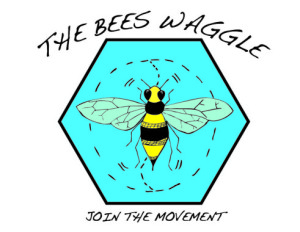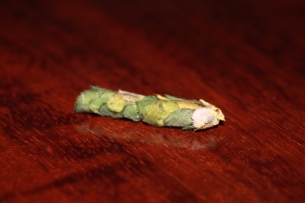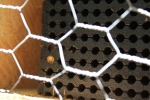Leafcutter Bees are Great Craftswomen!
All About Leafcutter Bees
by TheBeesWaggle
Any name with cutter in it seems frightening, but I am here to redeem these Leafcutter Bees of such a stigma by bringing understanding through education.
Leaf-cutter bees are another native species of bees found in most parts of North America. They are smaller than a honeybee, and have darker stripes paired with pastel yellow colored stripes across the abdomen.
The scientific name for this species is Megachilidae, and their name says it all, they do cut leaves for a purpose. They get their name from the way they use pieces of leaves to form egg cells which they then store in long, hollow cavities. They use a glue-like substance from glands near their mouths to sew pieces of leaves together, which they have carved from leaves of lilacs and other broad-leafed plants. The shape is that of a half-moon, and the size of the piece they take is very consistent. They only take as much as they need, never destroying the plants from which they take the leaf fragments.
Half-moon cuts on my lilac bush.
A row of beautifully crafted nesting cells from my leafcutter bee house.
Leafcutter bees are a solitary breed, like the mason bee. This translates into a more docile creature with nothing to defend but her life. So the only time she would sting would be to defend her life, and this is a rare occurrence, making her a very welcoming guest in your own yard! I have spent many minutes peering into the nesting blocks while these busy bees fly in and out going about their nesting business. I never once felt threatened by them, and in fact, felt ignored, entirely! This is also true of the nature of mason bees.
However, unlike mason bees, leaf-cutter bees will do their own excavating of soft rotting wood, or holes in thick stemmed plants, and in any conveniently located crevice. They also like having conveniently located nesting blocks with inviting holes as well, and we had success with them nesting in ours this summer! Nesting blocks need protection, so they must be paired with a nice house, and we have many options!
- There is one row capped with leaves! And there is a leafcutter bee going into another row to nest.
- Here she is coming out!
- Three rows capped!
- Here is how the nesting cells appear in the nesting block.
Like mason bees, leafcutter bees are very good pollinators compared to the honey bee. One leaf-cutter bee can pollinate at least what 20, and even up to 40, honey bees can pollinate. Leaf-cutter bees do not have pollen carrying baskets on their hind legs, but they do carry lots of pollen via static cling created by the hairs on their abdomen. The way they visit flowers is much like the mason bees, diving into the pollen as they fly from flower to flower. This techniques sets them apart from honeybees and makes them very effective pollinators.
Finally, leaf-cutter bees do not make honey, but they cultivate quite the production of food sources through their fierce pollinating efforts, and it would be foolish not to recognize this talent useful to us as humans. Like the honeybee, leafcutter bees, along with all other species of bees, need our help! Become a great host to these fascinating creatures, along with other species of pollinators, by setting up a complete habitat for them next Spring!












Leave a Reply
Want to join the discussion?Feel free to contribute!